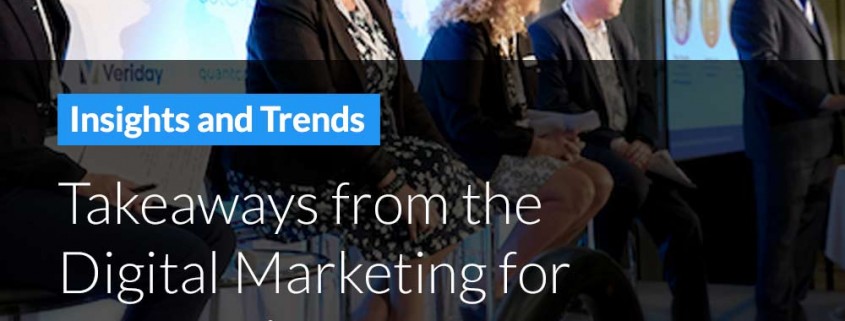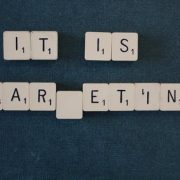Takeaways from the Digital Marketing for Financial Services Summit 2016
I recently attended the Digital Marketing Summit in Toronto and was a panelist on the Power Panel: Surmount Barriers to Transform your Omni-channel into a Customer Centric, High Performance Digital Ecosystem. The conference was very educational and a great way to meet industry leaders in the Digital world of Financial Services. Having learned some new perspectives on all things digital, I wanted to share some of my thoughts on two presentations that stood out during the conference.
The Keynote Address by Mitch Joel
The keynote address “Reboot Your Digital Marketing Strategy to Transform Your Brand and Win in the New Landscape” by Mitch Joel, President of Mirum, and author of Six Pixels of Separation and CTRL ALT DELETE was the most interesting. His presentation provided me with a different perspective on digital today.
The first was Mitch’s story about Snapchat. Apparently, in Snapchat’s very early days, when it was only about 5 people, Facebook offered to buy it for $3 billion. Amazingly, Snapchat’s founders turned it down. Snapchat’s size and younger audience demographic was attractive to Facebook, but Mitch explained that Snapchat was quite different from Facebook. Snapchat represented the real world. In the real world, most conversations are not recorded.
Today, in the ‘virtual world’, what people really want is an in-the-moment experience and to interact in a non-recorded way. Snapchat, and tools like Slack and Periscope, provide the brevity and genuineness of reacting to something as it happens, just like real life.
Teenagers need unstructured time online without fear of parental criticism, which can easily happen on social media platforms like Facebook and Instagram. Snapchat gives younger audiences the freedom of communicating in a private digital environment. Similarly, ‘Periscope’ lets you broadcast live video to the world. Followers can join, comment and “send you hearts in real time”. In the workplace, Slack, a chatting application, has been encroaching on email as a form of business communication. Email is still quite formal but conversely Slack allows for creativity and brainstorming — similar to a face-to-face meeting. Slack imitates that experience better than prescribed emails that most work-forces use.
Apps like Snapchat, Periscope and Slack prompt us, as marketers, to think about ways our own brands can mimic ‘real world’ experiences to connect not only with millennials but also with all of our customers in the ways they connect with each other.
Another interesting tidbit from Mitch was that Amazon bought the gaming channel, Twitch Interactive, in 2014 for almost $1 billion. Twitch is not actually a gaming website but an Internet video channel for “broadcasting and watching people play videogames”.
At first glance this seems like an awkward acquisition, however, Twitch is the fourth-largest source of U.S. Internet traffic, so perhaps $1 billion was worth it.
Mitch’s take away from this acquisition is that companies should obviously be investing in video, but also that thinking differently about your business can sometimes lead to tremendous success. An ecommerce and cloud computing company is leading the way with Amazon Prime video streaming and networks like Twitch. It is now not just about content or channels, but about networks like Netflix and CraveTV. Mitch Joel states that Amazon’s move into networks teaches us a potentially new way for marketers to think. Many brands are hiring journalists and other media types as a way to create more authentic, creative stories. He says that maybe the opportunity is for brands to think about not just creating and publishing content, but more about how to “become their own media network”. Perhaps the future is less about native advertising and more about brands becoming a network with their own studio.
Think about Purina owning a ‘kitty network’ similar to AFV or Elon Musk owning a “sustainability network’ that is all about saving the environment.
Another very interesting comment Mitch made was that the ‘purchase button’ should be everywhere. He mentioned the Best Buy Facebook Page that has a tab titled, “Shop Now”. Mitch says, why drive people back to your website when they should be able to buy right from within Facebook? The Internet strategy of years ago that drove consumers back to their website is slowly dying. This rang particularly true for me because in 2001, I worked for a ‘dot com’ called ePod. ePod had a unique advertising technology, that was way before its time. We called it a ‘website within a website’. We worked with companies like Disney to create an ad unit that would advertise a Disney product in a video, inside an ad unit with a ‘buy now’ or ‘add to cart’ functionality built-in. Yes, ePod was quite a way before its time.
My final takeaways from Mitch’s presentation were that we, as financial services marketers, need to ensure that we represent real-life. Marketing with flexibility, creativity, authenticity, and kindness. He said those were the keys to developing great businesses.
In a digitally centric world, authenticity and creating and developing real relationships are the keys to success.
Facebook’s Erin Elofson
Erin Elofson, Director of Financial Services at Facebook, sold the benefits of Facebook advertising, but she did it in a very educational way. I have spent a fair bit of time trying to find the secrets to effective Facebook advertising – with some great success – but I always thought that we could do better. Of course, video advertising was lauded as the key to success.
Video on Facebook has exploded, but the most enlightening was Erin’s comments on storytelling and driving people down the purchasing funnel. In hindsight, it is common sense, but Erin’s examples and success stories sent a strong message to the DMFS audience.
If you are a believer in content marketing, then you know that ebooks, case studies and blogs that educate the consumer before asking them to buy are significantly more effective than content that immediately asks people to take action1. Erin says that Facebook advertising should do the same. Campaigns that “sequence” different ads work best. The first ad should tell the brand story. For example, “our community focused bank supports people who lost their homes in Fort McMurray with a 1% mortgage”. The next ad in the “sequence” should provide product information. For example, “our friendly bank will easily transfer your mortgage over from another bank with no penalty”. Only after these two ads have run one after the other, should the message include a call-to-action such as stating the current mortgage rate and inviting the audience to click to apply. Erin also showed a simple formula for taking existing television or YouTube video ads and paring them back to become effective brand stories in Facebook.
From personal experiences, acting too quickly by asking people to take action immediately, without persuading them down the purchasing funnel through story telling, takes discipline. In a world where CEOs and shareholders are clamoring for quick results to meet quarter-end numbers, it is very tempting to ask prospects immediately to ‘buy-now’. I get many sales calls right after I download a piece of content. We often wrongly assume that if the product is as good as we think it is, or if they are the right target audience, they will buy. And if they don’t buy or click now, they never will. Erin brought American Express to the stage to tell their Facebook advertising story. American Express explained that once they adopted this disciplined approach to Facebook advertising, or ‘story telling’, the results were overwhelmingly positive. Research from Adaptly2, published by Facebook, concurs with the same results:
Among those who were exposed to the sequenced ads compared to those who were exposed to the non-sequenced ads, there was an 87% increase in people visiting the landing page and a 56% increase in subscription rates. In addition, they converted at higher rates.
When you think of this approach, it makes total sense. I am on Facebook reading my friends’ updates, looking at their photos, watching funny videos and reading news about a movie star’s dress. Do I really want some stranger telling me to buy their product? Wouldn’t it be better to see funny videos or moving stories related to the brand to get to know them before I am asked to buy?
“Some advertisers may find it counterintuitive to elongate a campaign as a way to more gradually bring their audience through the purchase funnel, rather than more immediately delivering a call-to-action,” says Adaptly’s CEO, Nikhil Sethi. “But we have proven that this classic brand-building approach it is both effective and efficient, even for direct response advertising.”3
My most memorable brand video on Facebook was the Westjet Christmas Miracle. That doubled my affinity for the airline. My resulting perception is a kind airline that cares about their people and their customers. As a marketer, I am surprised that I would feel that way about a brand solely based on their marketing.
Other themes of the Digital Marketing Financial Summit, were personalization, utilizing data to deliver better customer experiences, omni-channel challenges, using attribution for measuring advertising and more. Lastly, as a regular conference participant, I was very pleased to see how engaged the attendees were. Attendees had many questions for the presenters. When visiting our booth, they were open to hearing about our products and services rather than just the giveaways we had at the booth.
Conferences like DMFS provide us with the ability to step outside the office to learn, develop relationships, and talk to people in the “real world”.



![8 Web Design Trends That Will Take 2016 By Storm [Infographic] 8 Web Design Trends That Will Take 2016 By Storm [Infographic]](https://veriday.com/wp-content/uploads/2015/12/pexels-photo-261706-180x180.jpeg)







